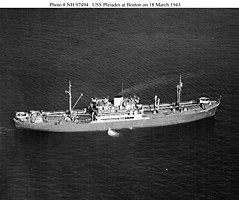Cavarna (ship, 1939)
|
The sister ship Mangalia in 1943 as USS Pleiades (AK-46)
|
||||||||||||||
|
||||||||||||||
|
||||||||||||||
|
||||||||||||||
|
||||||||||||||
The Cavarna was a Romanian passenger and cargo motor ship built in 1939 for the shipping company Serviciul Maritim Român . During the Second World War , the Navy took over the ship in 1941 and planned to convert it into a transport ship for the wounded . In December 1941 it sank in the Black Sea after a mine hit .
Construction and technical data
At the request of the shipping company “Serviciul Maritim Român” (SMR), the keel was laid at the Cantieri Navali Riuniti shipyard in the Palermo plant under construction number 136 . The launch took place in September 1939 under the name Cavarna after the city of the same name Kawarna in Bulgaria , which belonged to Romania from 1913 to 1940. In January 1940, the shipyard delivered the new building to the shipping company. The sister ships Mangalia , Balcic and Sulina ordered by SMR were also built at this shipyard .
Its length was 116.20 meters over everything, it was 15.40 meters wide and had a maximum draft of 7.11 meters. She was with 3495 BRT measured or 2022 NRT and had a capacity of 5,000 dwt The drive consisted of a. Fiat - six-cylinder - diesel engine whose power 3200 hp was. This acted on a screw , the ship reached a speed of 15.5 knots . The range was 9125 nautical miles at 12 knots. In addition to the crew of 44 men, up to 16 passengers could travel. As a transport ship for the wounded, it was equipped with two 2.0 cm anti-aircraft guns.
history
Romanian combined ship
After delivery of the yard to the shipping company SMR was Cavarna in Constanta registered as a home port. The "Serviciul Maritim Român" had planned to use the Cavarna like her sister ships for liner services across the Mediterranean. After the beginning of the war in 1939, the shipping company could only use the Cavarna from Romania on the safe routes to the Middle East and the eastern Mediterranean. After Romania entered the war on the side of the Axis Powers on June 21, 1941, the Romanian government chartered the Cavarna to the Navy.
German wounded transporter
After the German invasion of the Soviet Union ( Operation Barbarossa ) began, the Navy had a need for hospital ships in the Black Sea as well. Since the Soviet side did not recognize hospital ships in principle, it was planned as a transport for wounded and designed for 60 wounded. With this status, it was also able to transport troops and supplies to the front and was armed with two 20 mm anti-aircraft guns. It is unclear whether the ship was used as a transport for the wounded.
As with all hospital ships in the Black Sea, there are (no longer) any documents relating to the Cavarna's operations . Only a few pieces of information are known: On December 1, 1941, the Cavarna was attacked in vain by the Soviet submarine D-4 . A day later, on December 2, 1941, the Cavarna sank on a Soviet mine. In literature, both “Odessa” and “Burgas” can be found as places of decline.
literature
- Erich Gröner , Dieter Jung, Martin Maass: The German warships 1815-1945. Volume 5: Auxiliary Ships II: Hospital Ships, Residential Ships, Training Ships, Research Vehicles, Port Service Vehicles. Bernard & Graefe Verlag, Koblenz 1988, ISBN 3-7637-4804-0 .
- Reinhart Schmelzkopf: Foreign ships in German hands 1939–1945. Strandgut-Verlag, Cuxhaven 2004, DNB 972151001 .
- Rudolf Schmidt, Arnold Kludas : The German hospital ships in the Second World War. Motorbuch Verlag, Stuttgart 1978, ISBN 3-87943-560-X .
- Volker Hartmann, Hartmut Nöldeke : Wound transport by sea: German hospital and wound transport ships in the Second World War. (= Small series of publications on military and naval history. Volume 20). Winkler Verlag, Bochum, 2010, ISBN 978-3-89911-142-2 .
Web links
- Wounded Transport Ships (VTS) from Chronicle of Sea War, accessed on January 3, 2019
- Story and photo by SMR Sulina ; Balcic , Cavarna , Mangalia at romaniaforum.info, accessed on January 3, 2019
- submarine D-4 / Revolutsyner at uboat.net, accessed on January 3, 2019
- MV Cavarna (+1 941) at wrecksite.eu, accessed on January 3, 2019
Footnotes
- ↑ a b c melt head, p. 49
- ↑ a b c d Gröner, p. 54
- ↑ a b story and photo of SMR Sulina ; Balcic , Cavarna , Mangalia, romaniaforum.info
- ^ Schmidt, Kludas, p. 85, p. 157
- ↑ Chronicle of Naval Warfare: December 1–16, 1941 Black Sea
- ↑ Donald Bertke, Gordon Smith, Don Kindell: World War II Sea War, Vol. 5: Air Raid Pearl Harbor. This Is Not a Drill Bertke Publications, Dayton OH 2013, ISBN 978-1 937470-05-0 , p. 63 ( limited preview in Google book search )
- ↑ submarine D-4 / Revolutsyner at uboat.net
